
The black-necked weaver is a resident breeding bird species in much of central Africa from Cameroon in the west to Kenya and southern Somalia in the east.
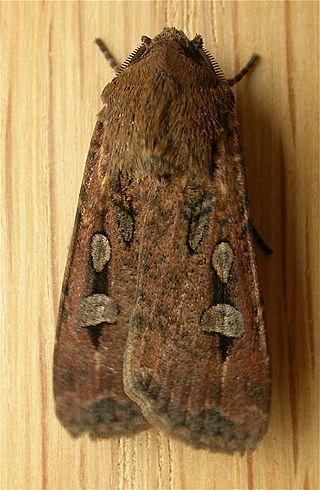
The bogong moth is a temperate species of night-flying moth, notable for its biannual long-distance seasonal migrations towards and from the Australian Alps, similar to the diurnal monarch butterfly. During the autumn and winter it is found in southern Queensland, western New South Wales, western Victoria, and also in South and Western Australia. Adult bogong moths breed and larvae hatch during this period, consuming winter pasture plants during their growth. During the spring, the moths migrate south or east and reside in mountains such as Mount Bogong, where they gregariously aestivate over the summer until their return towards breeding grounds again in the autumn.

A black fly or blackfly is any member of the family Simuliidae of the Culicomorpha infraorder. It is related to the Ceratopogonidae, Chironomidae, and Thaumaleidae. Over 2,200 species of black flies have been formally named, of which 15 are extinct. They are divided into two subfamilies: Parasimuliinae contains only one genus and four species; Simuliinae contains all the rest. Over 1,800 of the species belong to the genus Simulium.
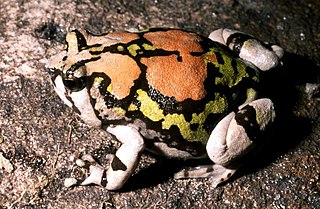
Scaphiophryne is a genus of microhylid frogs endemic to Madagascar. Some of the species are strikingly marked, while others are highly cryptic. They are rather plump and generally found on the ground. Several species in the genus are threatened because of habitat loss and overcollection for the international pet trade.

The blunt-headed salamander is a mole salamander endemic to Mexico. It is only known from the vicinity of its type locality, near Morelia, in Michoacán state in Southwestern Mexico. It inhabits a landscape consisting of a mosaic of natural grasslands and pine-oak forests at elevations of about 2,000 m (6,600 ft) asl. Breeding takes place in ponds. An average adult has a mass of 6.18 grams while wet. Adult females of the species range from 42-93 mm and males range from 45.4-70.5 mm in standard length.

The black colobus, or satanic black colobus, is a species of Old World monkey belonging to the genus Colobus. The species is found in a small area of western central Africa. Black colobuses are large, completely covered with black fur, and like all other Colobus monkeys, do not have a thumb. The species has faced large declines in population due to habitat destruction and hunting by humans, and was consequently listed as Vulnerable on the IUCN Red List in 1994.

Leucocytozoon is a genus of parasitic alveolates belonging to the phylum Apicomplexa.

The four-digit toad or dwarf toad is a species of toad in the family Bufonidae. It is found in Bioko, southwestern Cameroon, and southeastern Nigeria. It is the only species in the genus Didynamipus.
Leptopelis modestus is a species of frog in the family Arthroleptidae. Its common names are modest forest treefrog and plain tree frog.
Phlyctimantis boulengeri is a species of frog in the family Hyperoliidae. Its distribution area consists of three disjunct areas: western one in Ivory Coast, southeastern Guinea, Liberia, and southern Ghana, and another one in southeastern Nigeria, western Cameroon, and Gabon, and finally, the Bioko island. The record from Gabon may refer to Phlyctimantis leonardi, and the western populations might belong to an undescribed species. It occurs in secondary forests, forest clearings, and farm bush. Breeding takes place in larger temporary ponds in forest.

The Junaluska salamander is a species of lungless salamander native to the south-eastern United States. It was first described by David M. Sever, Harold M. Dundee, and Charles D. Sullivan who found the species in the range from the Cheoah River, Santeetlah Creek, and Tululah Creek in Graham County of North Carolina. Adults of this species can be found near large, rocky streams and on rainy nights on roads in the areas specified. The salamander is characterized by brownish-yellow coloration with a series of small dots along the body and a robust build compared to the other salamanders in Eurycea. The Junaluska salamander's breeding habits tend to be in large streams where the eggs are laid and attached to the bottom of rocks in the streams where they are found. According to the overall conservation listing for IUCN, this species is listed as Vulnerable. Conservation acts are important in both North Carolina and Eastern Tennessee, since the population of this species in each state is so small.
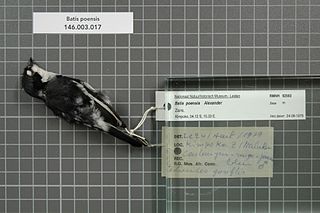
The Fernando Pó batis, also known as the Bioko batis, is a species of bird in the family Platysteiridae. It is endemic to the island of Bioko in Equatorial Guinea.

The red-eared guenon, also called red-eared monkey or russet-eared guenon, is a primate species in the family Cercopithecidae. It is native to subtropical and tropical moist lowland forests in Cameroon, Equatorial Guinea and Nigeria. It is listed as Vulnerable on the IUCN Red List and is threatened by habitat loss, illegal bushmeat hunting and pet trade.

The Nigerian shrew is a species of mammal in the family Soricidae. The animal is found in Benin, Burkina Faso, Cameroon, Ivory Coast, Nigeria, Togo, and there are claims of it also being found in Ghana. Its natural habitat is subtropical or tropical moist lowland forests.
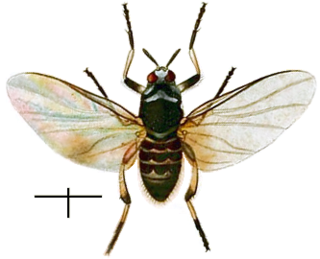
Simulium is a genus of black flies, which may transmit diseases such as onchocerciasis.
The Kulfo River is a river in southern Ethiopia that rises in the western escarpment of the Main Ethiopian Rift in the Guge mountains.
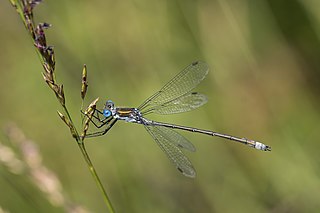
Lestes sponsa is a damselfly with a wide Palaearctic distribution. It is known commonly as the emerald damselfly or common spreadwing. Both males and females have a metallic green colour and brown wing spots. It resides near pools with aquatic plants. When resting its wings are usually half opened.
Simulium buissoni, commonly referred to as the black nono or no-no noir des rivières, is a midge species in the genus Simulium found on Nuku Hiva and Eiao, Marquesas archipelago in Polynesia.

Panulirus ornatus is a large spiny lobster with 11 larval stages.

The drill is a primate of the family Cercopithecidae, related to baboons and even more closely to mandrills.
















